check engine light BUICK ENCLAVE 2008 User Guide
[x] Cancel search | Manufacturer: BUICK, Model Year: 2008, Model line: ENCLAVE, Model: BUICK ENCLAVE 2008Pages: 436
Page 249 of 436
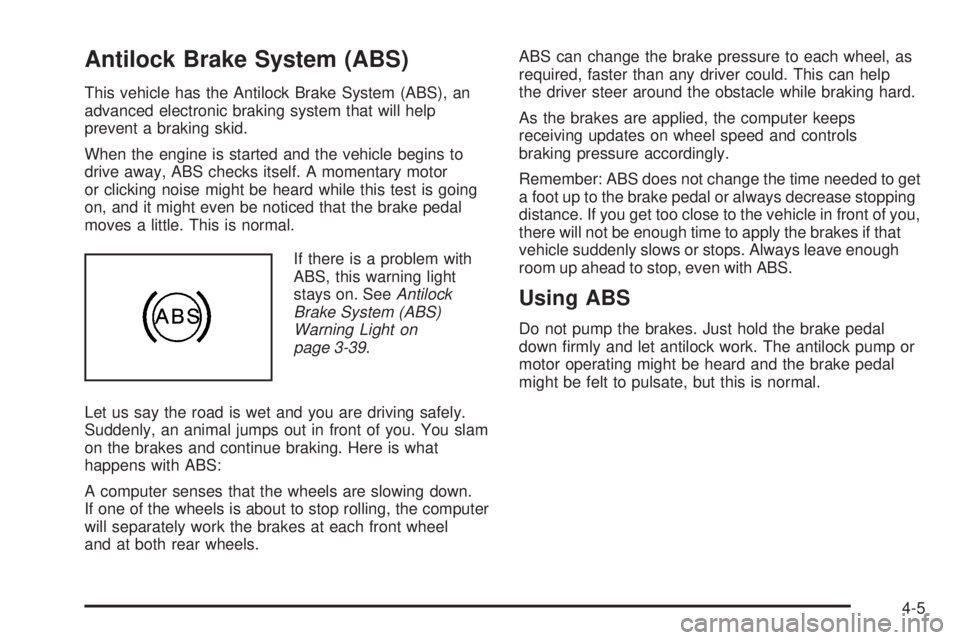
Antilock Brake System (ABS)
This vehicle has the Antilock Brake System (ABS), an
advanced electronic braking system that will help
prevent a braking skid.
When the engine is started and the vehicle begins to
drive away, ABS checks itself. A momentary motor
or clicking noise might be heard while this test is going
on, and it might even be noticed that the brake pedal
moves a little. This is normal.
If there is a problem with
ABS, this warning light
stays on. SeeAntilock
Brake System (ABS)
Warning Light on
page 3-39.
Let us say the road is wet and you are driving safely.
Suddenly, an animal jumps out in front of you. You slam
on the brakes and continue braking. Here is what
happens with ABS:
A computer senses that the wheels are slowing down.
If one of the wheels is about to stop rolling, the computer
will separately work the brakes at each front wheel
and at both rear wheels.ABS can change the brake pressure to each wheel, as
required, faster than any driver could. This can help
the driver steer around the obstacle while braking hard.
As the brakes are applied, the computer keeps
receiving updates on wheel speed and controls
braking pressure accordingly.
Remember: ABS does not change the time needed to get
a foot up to the brake pedal or always decrease stopping
distance. If you get too close to the vehicle in front of you,
there will not be enough time to apply the brakes if that
vehicle suddenly slows or stops. Always leave enough
room up ahead to stop, even with ABS.
Using ABS
Do not pump the brakes. Just hold the brake pedal
down �rmly and let antilock work. The antilock pump or
motor operating might be heard and the brake pedal
might be felt to pulsate, but this is normal.
4-5
Page 282 of 436

Gasoline Octane
If the vehicle has the 3.9L V6 engine (VIN Code 1) or the
3.9L V6 engine (VIN Code M), use regular unleaded
gasoline with a posted octane rating of 87 or higher. If the
octane rating is less than 87, you might notice an audible
knocking noise when you drive, commonly referred to
as spark knock. If this occurs, use a gasoline rated at
87 octane or higher as soon as possible. If you are using
gasoline rated at 87 octane or higher and you hear heavy
knocking, the engine needs service.
If the vehicle has the 4.6L V8 engine (VIN Code 9), use
premium unleaded gasoline with a posted octane rating
of 91 or higher. You can also use regular unleaded
gasoline rated at 87 octane or higher, but the vehicle’s
acceleration could be slightly reduced, and you might
notice a slight audible knocking noise, commonly referred
to as spark knock. If the octane is less than 87, you might
notice a heavy knocking noise when you drive. If this
occurs, use a gasoline rated at 87 octane or higher as
soon as possible. Otherwise, you could damage the
engine. If you are using gasoline rated at 87 octane or
higher and you hear heavy knocking, the engine needs
service.
Gasoline Speci�cations
At a minimum, gasoline should meet ASTM speci�cation
D 4814 in the United States or CAN/CGSB-3.5 or 3.511 in
Canada. Some gasolines contain an octane-enhancing
additive called methylcyclopentadienyl manganese
tricarbonyl (MMT). We recommend against the use of
gasolines containing MMT. SeeAdditives on page 5-7
for additional information.
California Fuel
If the vehicle is certi�ed to meet California Emissions
Standards, it is designed to operate on fuels that meet
California speci�cations. See the underhood emission
control label. If this fuel is not available in states adopting
California emissions standards, the vehicle will operate
satisfactorily on fuels meeting federal speci�cations, but
emission control system performance might be affected.
The malfunction indicator lamp could turn on and the
vehicle might fail a smog-check test. SeeMalfunction
Indicator Lamp on page 3-43. If this occurs, return to your
authorized dealer/retailer for diagnosis. If it is determined
that the condition is caused by the type of fuel used,
repairs might not be covered by the vehicle warranty.
5-6
Page 299 of 436
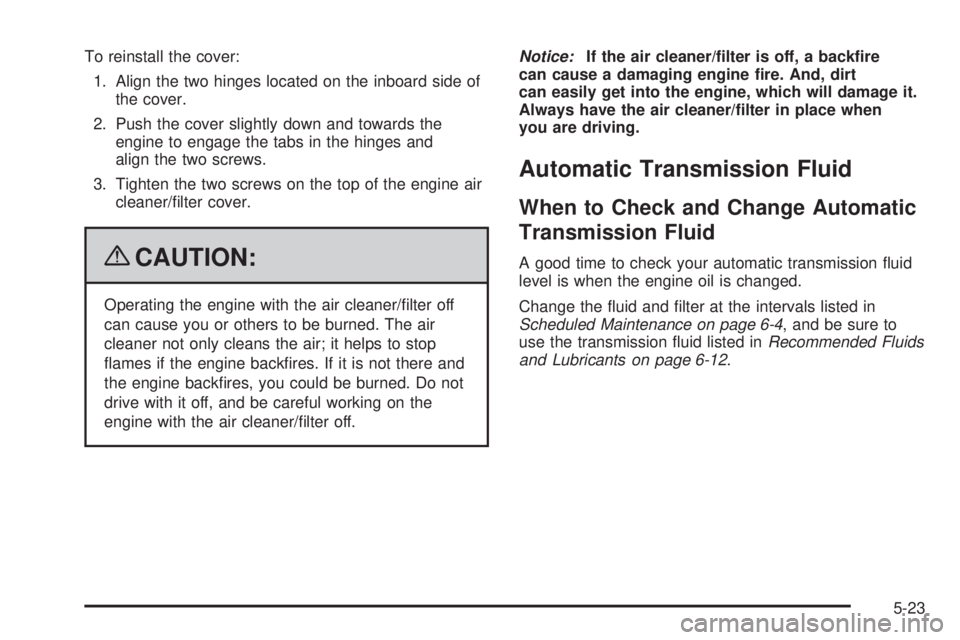
To reinstall the cover:
1. Align the two hinges located on the inboard side of
the cover.
2. Push the cover slightly down and towards the
engine to engage the tabs in the hinges and
align the two screws.
3. Tighten the two screws on the top of the engine air
cleaner/�lter cover.
{CAUTION:
Operating the engine with the air cleaner/�lter off
can cause you or others to be burned. The air
cleaner not only cleans the air; it helps to stop
�ames if the engine back�res. If it is not there and
the engine back�res, you could be burned. Do not
drive with it off, and be careful working on the
engine with the air cleaner/�lter off.Notice:If the air cleaner/�lter is off, a back�re
can cause a damaging engine �re. And, dirt
can easily get into the engine, which will damage it.
Always have the air cleaner/�lter in place when
you are driving.
Automatic Transmission Fluid
When to Check and Change Automatic
Transmission Fluid
A good time to check your automatic transmission �uid
level is when the engine oil is changed.
Change the �uid and �lter at the intervals listed in
Scheduled Maintenance on page 6-4, and be sure to
use the transmission �uid listed inRecommended Fluids
and Lubricants on page 6-12.
5-23
Page 311 of 436
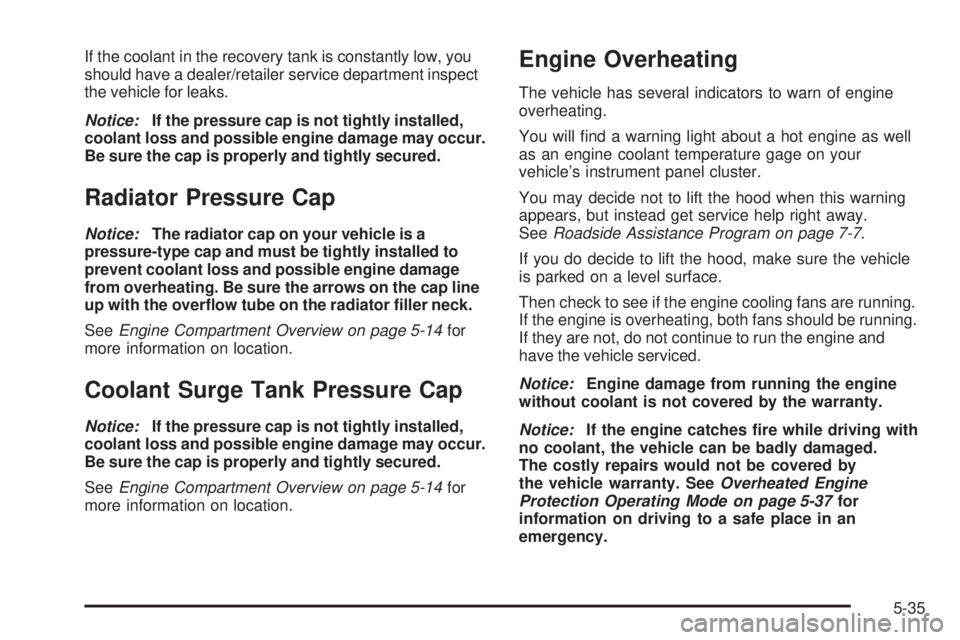
If the coolant in the recovery tank is constantly low, you
should have a dealer/retailer service department inspect
the vehicle for leaks.
Notice:If the pressure cap is not tightly installed,
coolant loss and possible engine damage may occur.
Be sure the cap is properly and tightly secured.
Radiator Pressure Cap
Notice:The radiator cap on your vehicle is a
pressure-type cap and must be tightly installed to
prevent coolant loss and possible engine damage
from overheating. Be sure the arrows on the cap line
up with the over�ow tube on the radiator �ller neck.
SeeEngine Compartment Overview on page 5-14for
more information on location.
Coolant Surge Tank Pressure Cap
Notice:If the pressure cap is not tightly installed,
coolant loss and possible engine damage may occur.
Be sure the cap is properly and tightly secured.
SeeEngine Compartment Overview on page 5-14for
more information on location.
Engine Overheating
The vehicle has several indicators to warn of engine
overheating.
You will �nd a warning light about a hot engine as well
as an engine coolant temperature gage on your
vehicle’s instrument panel cluster.
You may decide not to lift the hood when this warning
appears, but instead get service help right away.
SeeRoadside Assistance Program on page 7-7.
If you do decide to lift the hood, make sure the vehicle
is parked on a level surface.
Then check to see if the engine cooling fans are running.
If the engine is overheating, both fans should be running.
If they are not, do not continue to run the engine and
have the vehicle serviced.
Notice:Engine damage from running the engine
without coolant is not covered by the warranty.
Notice:If the engine catches �re while driving with
no coolant, the vehicle can be badly damaged.
The costly repairs would not be covered by
the vehicle warranty. SeeOverheated Engine
Protection Operating Mode on page 5-37for
information on driving to a safe place in an
emergency.
5-35
Page 324 of 436

{CAUTION:
Using a match near a battery can cause battery
gas to explode. People have been hurt doing this,
and some have been blinded. Use a �ashlight if
you need more light.
Be sure the battery has enough water. You do not
need to add water to the battery installed in your
new vehicle. But if a battery has �ller caps, be
sure the right amount of �uid is there. If it is low,
add water to take care of that �rst. If you do not,
explosive gas could be present.
Battery �uid contains acid that can burn you.
Do not get it on you. If you accidentally get it in
your eyes or on your skin, �ush the place with
water and get medical help immediately.
{CAUTION:
Fans or other moving engine parts can injure you
badly. Keep your hands away from moving parts
once the engine is running.
5. Check that the jumper cables do not have loose
or missing insulation. If they do, you could get a
shock. The vehicles could be damaged too.
Before you connect the cables, here are some
basic things you should know. Positive (+) will go to
positive (+) or to a remote positive (+) terminal if
the vehicle has one. Negative (−) will go to a heavy,
unpainted metal engine part or to a remote
negative (−) terminal if the vehicle has one.
Do not connect positive (+) to negative (−)oryou
will get a short that would damage the battery
and maybe other parts too. And do not connect the
negative (−) cable to the negative (−) terminal on
the dead battery because this can cause sparks.
5-48
Page 394 of 436
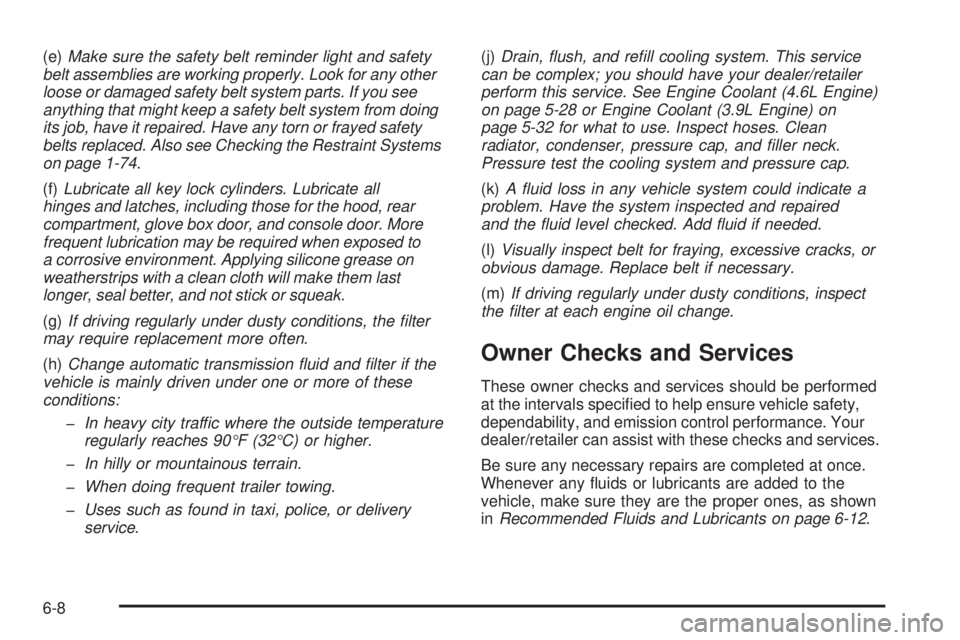
(e)Make sure the safety belt reminder light and safety
belt assemblies are working properly. Look for any other
loose or damaged safety belt system parts. If you see
anything that might keep a safety belt system from doing
its job, have it repaired. Have any torn or frayed safety
belts replaced. Also see Checking the Restraint Systems
on page 1-74.
(f)Lubricate all key lock cylinders. Lubricate all
hinges and latches, including those for the hood, rear
compartment, glove box door, and console door. More
frequent lubrication may be required when exposed to
a corrosive environment. Applying silicone grease on
weatherstrips with a clean cloth will make them last
longer, seal better, and not stick or squeak.
(g)If driving regularly under dusty conditions, the filter
may require replacement more often.
(h)Change automatic transmission fluid and filter if the
vehicle is mainly driven under one or more of these
conditions:
�In heavy city traffic where the outside temperature
regularly reaches 90°F (32°C) or higher.
�In hilly or mountainous terrain.
�When doing frequent trailer towing.
�Uses such as found in taxi, police, or delivery
service.(j)Drain, flush, and refill cooling system. This service
can be complex; you should have your dealer/retailer
perform this service. See Engine Coolant (4.6L Engine)
on page 5-28 or Engine Coolant (3.9L Engine) on
page 5-32 for what to use. Inspect hoses. Clean
radiator, condenser, pressure cap, and filler neck.
Pressure test the cooling system and pressure cap.
(k)A fluid loss in any vehicle system could indicate a
problem. Have the system inspected and repaired
and the fluid level checked. Add fluid if needed.
(l)Visually inspect belt for fraying, excessive cracks, or
obvious damage. Replace belt if necessary.
(m)If driving regularly under dusty conditions, inspect
the filter at each engine oil change.
Owner Checks and Services
These owner checks and services should be performed
at the intervals speci�ed to help ensure vehicle safety,
dependability, and emission control performance. Your
dealer/retailer can assist with these checks and services.
Be sure any necessary repairs are completed at once.
Whenever any �uids or lubricants are added to the
vehicle, make sure they are the proper ones, as shown
inRecommended Fluids and Lubricants on page 6-12.
6-8
Page 424 of 436

Audio System(s).............................................3-78
Automatic Transmission
Fluid..........................................................5-23
Operation...................................................2-25
B
Backglass Antenna........................................3-106
Battery..........................................................5-44
Electric Power Management..........................3-19
Exterior Lighting Battery Saver......................3-17
Inadvertent Power Saver..............................3-19
Run-Down Protection...................................3-20
Bluetooth
®.....................................................3-93
Brake
Emergencies................................................ 4-6
Brake Fluid....................................................5-40
Brakes..........................................................5-40
System Warning Light..................................3-38
Braking........................................................... 4-4
Braking in Emergencies..................................... 4-6
Break-In, New Vehicle.....................................2-20
Bulb Replacement...........................................5-54
Halogen Bulbs............................................5-54
Headlamp Aiming........................................5-51
License Plate Lamps....................................5-57Bulb Replacement (cont.)
Replacement Bulbs......................................5-57
Taillamps and Back-Up Lamps.......................5-56
Taillamps, Turn Signal, Stoplamps and
Sidemarker Lamps...................................5-54
Buying New Tires...........................................5-74
C
Calibration.....................................1-12, 2-34, 3-54
California Fuel.................................................. 5-6
California Perchlorate Materials Requirements....... 5-4
California Proposition 65 Warning....................... 5-4
Canadian Owners................................................ ii
Capacities and Speci�cations..........................5-109
Carbon Monoxide...........................2-13, 2-32, 4-15
Care of
Safety Belts................................................5-95
CD, MP3 .......................................................3-88
Center Console Storage Area...........................2-57
Center Flex Storage Unit.................................2-57
Center Seat...................................................1-12
Chains, Tire...................................................5-80
Charging System Light....................................3-38
Check
Engine Lamp..............................................3-43
2
Page 425 of 436

Checking Things Under the Hood......................5-12
Chemical Paint Spotting...................................5-99
Child Restraints
Child Restraint Systems...............................1-41
Infants and Young Children...........................1-38
Lower Anchors and Tethers for Children..........1-45
Older Children.............................................1-35
Securing a Child Restraint in a
Rear Seat Position...................................1-51
Securing a Child Restraint in the
Center Front Seat Position........................1-54
Securing a Child Restraint in the
Right Front Seat Position..........................1-54
Where to Put the Restraint...........................1-44
Cleaning
Aluminum or Chrome-Plated Wheels..............5-98
Exterior Lamps/Lenses.................................5-96
Fabric/Carpet..............................................5-93
Finish Care.................................................5-96
Instrument Panel, Vinyl, and Other Plastic
Surfaces.................................................5-95
Interior.......................................................5-92
Leather......................................................5-94
Tires..........................................................5-99
Underbody Maintenance...............................5-99
Washing Your Vehicle...................................5-96
Weatherstrips..............................................5-95
Windshield and Wiper Blades........................5-97Climate Control System...................................3-21
Air Filter, Passenger Compartment.................3-30
Dual Automatic............................................3-24
Outlet Adjustment........................................3-30
Clock, Setting.................................................3-76
Collision Damage Repair..................................7-12
Compact Spare Tire........................................5-91
Compass.......................................1-12, 2-34, 3-54
Content Theft-Deterrent....................................2-17
Control of a Vehicle.......................................... 4-3
Convenience Net............................................2-57
Coolant
Engine...............................................5-28, 5-32
Engine Temperature Gage............................3-42
Engine Temperature Warning Light.................3-42
Surge Tank Pressure Cap.............................5-35
Cooled Seats................................................... 1-7
Cooling System..............................................5-26
Cornering Lamps............................................3-17
Courtesy Lamps.............................................3-18
Cruise Control................................................3-12
Cruise Control Light........................................3-47
Cupholders....................................................2-57
Customer Assistance Information
Courtesy Transportation................................7-10
Customer Assistance for
Text Telephone (TTY) Users........................ 7-6
Customer Assistance Offices........................... 7-6
3
Page 427 of 436

Electronic Immobilizer Operation
PASS-Key®III+...........................................2-19
Engine
Air Cleaner/Filter.........................................5-22
Check and Service Engine Soon Lamp...........3-43
Coolant..............................................5-28, 5-32
Coolant Heater............................................2-24
Coolant Temperature Gage...........................3-42
Coolant Temperature Warning Light................3-42
Drive Belt Routing.......................................6-14
Engine Compartment Overview......................5-14
Exhaust.....................................................2-32
Oil .............................................................5-17
Oil Life System...........................................5-20
Overheated Protection Operating Mode...........5-37
Overheating................................................5-35
Starting......................................................2-22
Entry Lighting.................................................3-18
Event Data Recorders.....................................7-17
Extender, Safety Belt.......................................1-34
Exterior Lamps...............................................3-15
Exterior Lighting Battery Saver..........................3-17
F
Filter
Engine Air Cleaner......................................5-22
Finish Damage...............................................5-99
Flashers, Hazard Warning.................................. 3-6Flash-to-Pass................................................... 3-9
Flat Tire........................................................5-81
Flat Tire, Changing.........................................5-82
Flat Tire, Storing.............................................5-89
Fluid
Automatic Transmission................................5-23
Power Steering...........................................5-38
Windshield Washer......................................5-39
Fog Lamp
Fog ...........................................................3-17
Fog Lamp Light..............................................3-47
Front Reading Lamps......................................3-18
Front Storage Area.........................................2-57
Fuel............................................................... 5-5
Additives...................................................... 5-7
California Fuel.............................................. 5-6
Driving for Better Economy............................. 4-2
E85 (85% Ethanol)........................................ 5-8
Filling a Portable Fuel Container....................5-12
Filling the Tank...........................................5-10
Fuels in Foreign Countries.............................. 5-9
Gage .........................................................3-48
Gasoline Octane........................................... 5-6
Gasoline Speci�cations.................................. 5-6
Fuses
Fuses and Circuit Breakers.........................5-101
Rear Underseat Fuse Block.........................5-104
Underhood Fuse Block...............................5-101
5
Page 428 of 436
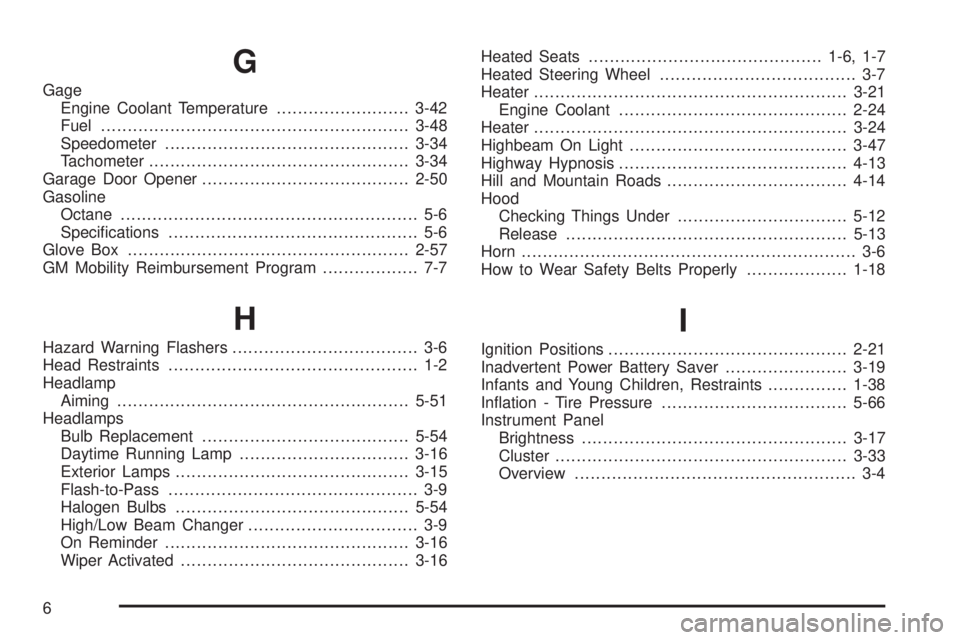
G
Gage
Engine Coolant Temperature.........................3-42
Fuel..........................................................3-48
Speedometer..............................................3-34
Tachometer.................................................3-34
Garage Door Opener.......................................2-50
Gasoline
Octane........................................................ 5-6
Speci�cations............................................... 5-6
Glove Box.....................................................2-57
GM Mobility Reimbursement Program.................. 7-7
H
Hazard Warning Flashers................................... 3-6
Head Restraints............................................... 1-2
Headlamp
Aiming .......................................................5-51
Headlamps
Bulb Replacement.......................................5-54
Daytime Running Lamp................................3-16
Exterior Lamps............................................3-15
Flash-to-Pass............................................... 3-9
Halogen Bulbs............................................5-54
High/Low Beam Changer................................ 3-9
On Reminder..............................................3-16
Wiper Activated...........................................3-16Heated Seats............................................1-6, 1-7
Heated Steering Wheel..................................... 3-7
Heater...........................................................3-21
Engine Coolant...........................................2-24
Heater...........................................................3-24
Highbeam On Light.........................................3-47
Highway Hypnosis...........................................4-13
Hill and Mountain Roads..................................4-14
Hood
Checking Things Under................................5-12
Release.....................................................5-13
Horn ............................................................... 3-6
How to Wear Safety Belts Properly...................1-18
I
Ignition Positions.............................................2-21
Inadvertent Power Battery Saver.......................3-19
Infants and Young Children, Restraints...............1-38
In�ation - Tire Pressure...................................5-66
Instrument Panel
Brightness..................................................3-17
Cluster.......................................................3-33
Overview..................................................... 3-4
6